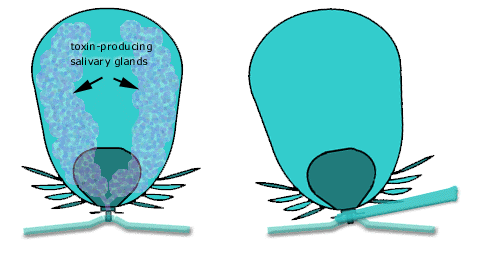Pet First Aid for paralysis ticks

What do I do if I find a tick on my dog or cat?
You should be cautious and assume that it might be a paralysis tick, as this is easily the most common type on the East Coast of Australia (see common ticks or identification, if required). If it is attached to the skin it is potentially dangerous. If it is wandering about it presents no immediate threat but the pet should be checked for more ticks and preferably have a tick-killing substance applied topically (thoroughly), or an insecticidal tablet given orally- see tick prevention products-proban
Do not panic. Although just as serious as a snake bite for pets, tick poisoning has a much slower onset (hours rather than minutes). Do not assume that tick removal is all that is required. Even when a tick has been removed it may take up to 48 hours for the worst signs of poisoning to develop.
FIRST determine if there are ANY clinical signs evident that might relate to the tick (see SIGNS TO LOOK FOR, below).
IF NO SIGNS AT ALL ARE EVIDENT
The tick should be removed. You might use fine tweezers, a tick-remover, a loop of cotton etc, grasping close to the skin, under the legs and body of the tick. If this is too difficult you can kill the tick by applying insecticide (usually pyrethrin or pyrethroid) or insect repellant (usually DEET) on soaked cotton wool for example- it will die and dessiccate after a few hours and later slough from the skin. For more discussion about tick removal see treatment-removal.
 |
|
| paralysis tick mouthparts (chelicerae and hypostome) embedded in the skin with the small palps splayed on the surface | tweezers or forceps can be used to pinch off the feeding tube (hypostome) and then traction (+/- rotation) used to dislodge it |
Check for more ticks and apply a tick-killing spray or rinse suitable for dog or cat (eg pyrethrin for cats, a pyrethroid for dogs). Fipronil (Frontline® as the Spray or Top Spot) will kill ticks but can take 24 hours to do so- it is best used for prevention.
The pet should be carefully observed for 48 hours- either at home, or otherwise in a veterinary hospital.
As a precaution avoid encouraging strenuous exertion.
Also limit food to smaller meals for this period.
Check whether after-hours veterinary attention is available in your area.
IF ANY SIGNS ARE EVIDENT
Be calm. Do not stress the pet by overhandling or too much unfamiliar attention. Some pets are psychologically stressed by the inability to walk properly. Others are breathing heavily or gasping for oxygen because their lungs are unable to absorb it properly. Others still are made very anxious by choking sensations. All of these are made worse by physical and psychological stress.
Seek veterinary attention. Phone local veterinarians for initial advice and to let them prepare for your arrival. You can remove or kill the tick yourself (as above) or have the veterinarian do this for you if it does not take too long to get to the veterinary hospital.
Prevent overheating. Transport is ideally air-conditioned- cool but not cold.
Do not give food or water
IF VETERINARY ATTENTION IS NOT AVAILABLE
Fortunately this is a rare situation. Without anti-tick serum there is little that one can actually do to speed recovery (if at all) and measures are supportive.
Minimise stress. In general, any kind of intervention can cause stress to the animal. Even for veterinarians, the acts of giving anti-tick serum and providing oxygen can be stressful but in these situations the benefit is deemed to outweigh the added risk, and animals are sedated when required. Minimise fussing. Allow access to fresh air (not too humid). Prevent overheating.
Do not give food or water. If the protective gag-reflex is not functioning, direct aspiration of food/water or indirect aspiration of vomitus will result in extremely rapid deterioration. Tick poisoned dogs and cats are often not given food or water for 24-48 hours. In veterinary hospitals they are thereafter given any required fluids by a drip method. Animals are better off slightly dehydrated than developing pneumonia through inhaling ingested food or water. Slight dehydration may even be beneficial if pulmonary oedema is present.
The animal is best kept lying on its chest (in sternal recumbency), with the head down. Some props may be used to help the animal keep this posture. Too much padding however can lead to overheating. Keep the head area free of obstructions as the animal may want to move the head from side to side and does not want to feel restricted. If saliva or vomitus is causing obvious choking (with mucous membranes blue) then the obstructive material needs to be removed quickly- swabbing out, suctioning, or briefly suspending with head down.
Wait. Again, try to seek veterinary attention.
Often signs can be obvious - weakness in the legs, especially hind legs, a drunken gait, muted barking or meowing, rapid noisy breathing, slow grunting breathing, coughing, gagging, drooling, vomiting. See also clinical signs for the many other early signs possible. The more of these signs combined, the more likely that it is caused by the tick.
Sometimes, however, signs are non-specific and vague- lethargy, not eating. You may need to "test" a pet for the ability to walk and vocalise normally. Try walking in tight circles, up stairs. Try to evoke a barking, howling or meowing response if you can. A muted sound suggests laryngeal paralysis induced by tick toxin.
Local paralysis of an eyelid or the side of the face caused by a nearby attached tick is occasionally an early sign. Such eyes may be red and have a mucoid discharge. You should regard these cases as potentially serious also.
Notes
Lethargy
Lethargy and loss of appetite as the only signs may represent the relatively rare situation of "mild" tick poisoning. There is reticence to be active but the animal can be roused to walk normally although it may continue to refuse to eat. These pets may be developing some immunity.
However, if any signs of gait abnormality or vomiting/gagging or breathing difficulty develop- then these signs nearly always progress to the full paralysis syndrome. In other words gait abnormalities, breathing difficulties, vomiting or gagging represent early signs rather than mild signs. Take advantage of the benefits of having anti-tick serum being given early- it is much more effective this way.
Whilst costs may be of concern , it is much less expensive to treat a simple case of tick posioning than it is to treat an advanced complicated case in which pneumonia and heart failure have developed.
Tick Size
Once an adult female tick is engorged to more than about 3 mm body length the size of the tick has no bearing on severity if clincial signs are present. A 4 mm (bodylength) engorged tick is just as potentially deadly as a 10 mm engorged tick.
Eye care
If eyelids are paralysed (no blink reflex) the eye's corneal surface may need to be moistened. You can use a sterile lubricant (eg K-Y), artifical tears, medical saline, or even a drop of corn oil or olive oil if the eye does not appear inflamed. Most antibiotic eye ointments are safe provided they do not contain any kind of cortisone.
What happens if my pet does not receive antiserum?
It is difficult to give statistical information about the chances of survival without antiserum because it would be ethically questionable to acquire this knowledge by experimentation. In general however, pets showing symptoms more than simply lethargy or a loss of appetite have a "guarded" prognosis for survival if not given antiserum. From a general interpretation of the scientific literature "most" or "the vast majority" of dogs not receiving antiserum will die (see treatment-dogs #prognosis). In contrast to this, only about 5% of dogs receiving antiserum will die (and these are usually those dogs that have received their antiserum at a late/advanced stage of tick poisoning). Dogs appear to be less likely to survive than cats. Cats certainly do die but I have no figures on survival for untreated cats.
In the days before antiserum was available dogs regularly died. Some farmers of the past seem to have regarded losing dogs to tick poisoning as a regrettable though inevitable part of their coastal rural existence. One hears that some dogs were left alone under the house and occasionally survived- the lack of stress, the shade and shelter and the accompanying mild dehydration may have helped the occasional dog to survive.
What is a pyrethroid?
Pyrethroids represent the synthetic variants of the naturally-occurring pyrethrins. They have been synthesised to enhance various anti-parasitic properties such as potency, spectrum and longevity. Pyrethrins are generally safe for most animals. Some pyrethroids, eg permethrin, can be toxic to cats.
The Paralysis Tick of Australia - Home
E-mail Us to report a broken link!